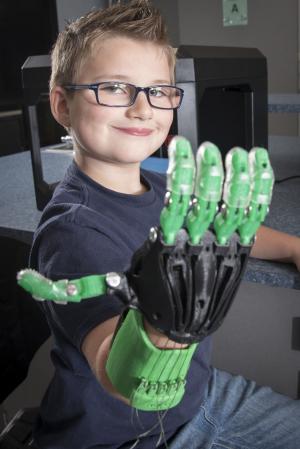Imagine having the project that springboards your academic (and possibly professional) career handed to you—literally. That’s exactly what happened to John Hughes, former student at Estrella Mountain Community College.
Hughes, now a mechanical engineering student at Arizona State University, was looking for a project for his Physics II final assignment. He had an interest in biomechanics and prosthetics, having written in his senior yearbook that he wanted to build limbs. But he hadn’t been able to find inspiration for what to do.
EMCC had recently received a new 3–D printer and David Weaver, engineering faculty and Hughes’s physics instructor, shared its capabilities with other EMCC employees. In a stroke of luck, an EMCC reading faculty member, Heather Muns, was in the audience.
When Muns was pregnant with her now eight–year–old son, Noah, he suffered a blood clot causing his right had to stop growing. He was born without a hand, but it has slowed him down little. Because he needed to grow into his body, Muns and her husband knew it didn’t make sense to get a prosthetic hand through traditional means—leading orthopedic doctors and engineers came with a high price tag.
“Other than aesthetics, a prosthetic wouldn’t do much for Noah,” said Muns. “And he’s really learned to fully function without [the hand]. We thought we’d wait until he was older to get a prosthetic.” But after David Weaver’s presentation, Muns approached him about her son. Weaver immediately knew she had to meet Hughes and that he had found Hughes’s final project—a prosthetic hand for Noah.
As luck would have it, Weaver knew Hughes was in the building for a class. He introduced the two and a project idea was born.
Hughes finished his coursework at EMCC in the spring, but even after classes ended for the summer he was still hard at work perfecting Noah’s prosthetic. The parts take 12 to 15 hours to print plus countless hours of sanding, drilling holes, and fitting it to Noah’s growing body.
“It’s a testament to Hughes’s dedication that he continued to work on the prosthetic months after his course was over,” said Weaver. Going on five months after Hughes finished his schooling at EMCC, he is still working to make sure Noah has a “hand” that is functional.
Hughes has been through four iterations of the prosthetic for Noah, always striving to find the most functional design and fit. Each new prototype requires new measurements and brings up new insights that both help the prosthetic be a little more comfortable for Noah and teach Hughes more about design.
“David has been a huge part of this project,” said Hughes. “He’s very passionate about outside activities and the students he teaches.”
The latest version of the prosthetic is larger than before, and Noah has yet to try it on. It includes an elbow attachment, allowing more flexibility since Noah has limited mobility and strength in his wrist. Hughes anticipates that the prosthetic will be done in one or two more iterations.
“I’m just so thankful for the opportunity and to put my knowledge into full effect,” said Hughes.
Currently, Weaver is collaborating with current EMCC engineering students to move forward with the development of prosthetics for Noah to use as he grows.

